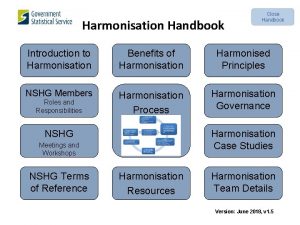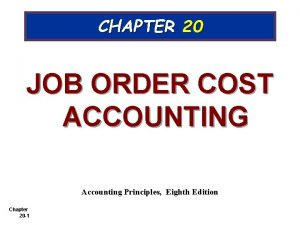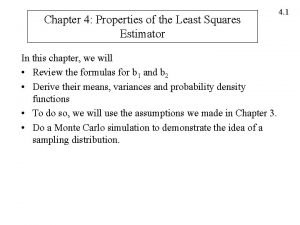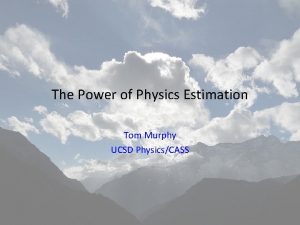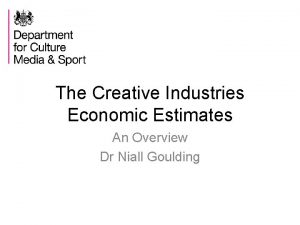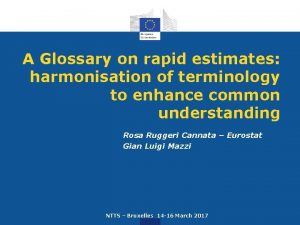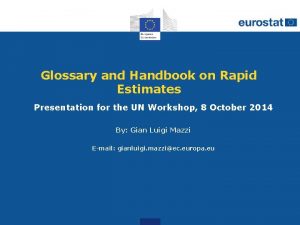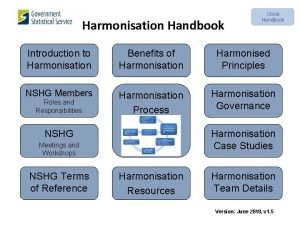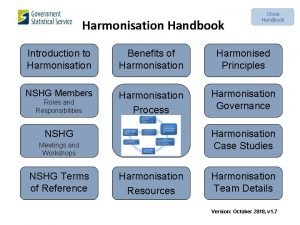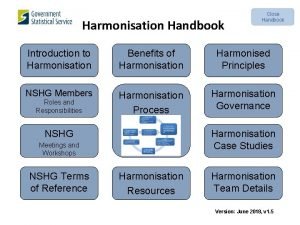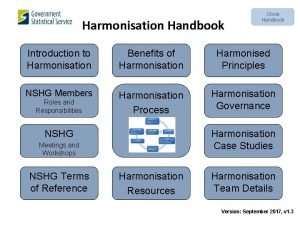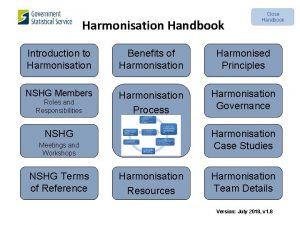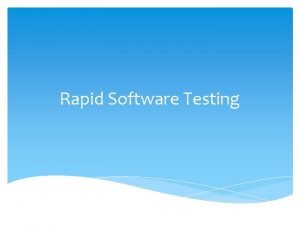A Glossary on rapid estimates harmonisation of terminology


















- Slides: 18

A Glossary on rapid estimates: harmonisation of terminology to enhance common understanding Rosa Ruggeri Cannata – Eurostat Gian Luigi Mazzi NTTS – Bruxelles 14 -16 March 2017

Glossary on Rapid Estimates Introduction • Lack of common terminology among countries and institutions when talking about rapid estimates • Same terminology used in very different contexts • Communication and common understanding issues • Need for a common vocabulary for various types of rapid estimates • Generally agreed • Based on a transparent and easily understandable logical framework • Eurostat leading the preparation of the glossary on rapid estimates 2

Examples of different terminologies • • Early estimate Flash estimate Nowcasting Rapid estimate 1 st, 2 nd estimate Advanced estimate Preliminary estimate Just a question of when are data released? Eurostat

Issues of interest Eurostat

Structure of the glossary I • Glossary built up around 4 main questions • Each question related to one or more axes of a theoretical hypercube • Each axis has a number of modalities 5

Structure of the glossary II Main questions: • Who? Who makes the evaluation (1 axis). • What? What is evaluated (2 axes). • How? How is the evaluation done (3 axes). • When? When is the evaluation done (2 axes). 6

Structure of the glossary III Who makes the evaluation (1 axis) Axis 1: The uniqueness of an official release vs. the potential multiplicity of evaluations • Producer of rapid estimates may or may not be the same as the producer of regular releases of a given indicator • Possible modalities • Statistical offices or members of the statistical system • Other governmental institutions • Private institutions 7

Structure of the glossary IV What is evaluated (2 axes) Axis 2. The target variable • Possible modalities • • Hard data Soft data Financial data Unconventional data 8

Structure of the glossary V What is evaluated (2 axes) Axis 3. Some revisions in the estimate • Theoretically speaking only data which is characterised by revisions can be the object of flash estimates or nowcasting but also data not subject to revisions can be forecasted • Possible modalities • Data subsequently revised • Data is not revised 9

Structure of the glossary VI How is the evaluation done (3 axes) Axis 4. The adherence to the regular production process • Possible modalities • Fully adherent to the regular production process • Partially adherent to the regular production process • Different than the regular production process 10

Structure of the glossary VII How is the evaluation done (3 axes) Axis 5. Information set • When estimating the target variable the information set on which the estimation is based may or may not include the totality of the information • In case of an incomplete coverage, statistical modelling used to fill the gaps • Defining a minimum acceptable coverage for each estimate • Possible modalities • Availability of the full information set for the period under estimation • Incomplete observation set for the period under estimation • Some variables could be observed only partially • No available information for the period under estimation

Structure of the glossary VIII How is the evaluation done (3 axes) Axis 6. Model/versus parameter uncertainty • Models used for rapid estimates differing for several reasons • Known/unknown data • Techniques implying parameters estimation (uncertainty) vs. Simple smoothing or adjustment techniques • Possible modalities • Statistical models • Econometric models 12

Structure of the glossary IX When is the evaluation done (2 axes) Axis 7. A proper reporting time • In defining rapid estimates the point in time at which they are produced is an essential discriminant • Obviously the frequency of the target variable influences the interpretation of various estimates • Possible modalities • Estimates produced before the reference period • Estimates produced during the reference period • Estimates produced after the end of the reference period, but not later than T+1/2 • … 13

Structure of the glossary X When is the evaluation done (2 axes) Axis 8: Stock and flow data/collecting and reference period • When data are collected and how they are defined also affect the interpretation of various estimates • A regular estimate for a flow variable cannot be produced before the end of the period while for a stock variable recorded at a given day or week of the reference period this would be possible • Possible modalities • Flow • Stock 14

Examples - Nowcasting • Produced by a statistical authority or an institution outside a statistical system • Target variable: hard data • Taking place for the reference period T during the period T itself or right at the end • Making use of all available information becoming available between T-1 and T until the estimation time • Using statistical and/or econometric models different from the regular production process • Hard, soft, financial, unconventional data 15

Examples – Flash estimates • Produced by statistical institutions in charge of the regular production of the concerned indicator • Target variable: hard data • Using an incomplete set of information exploiting as much as possible all available hard data • Soft data can be used to fill some gaps • Using as much as possible the same methodology as for regular estimates • Statistical techniques to deal with incomplete information set • Released as timely as possible after the end of the reference period • Ideally not later than T+1/2 16

Conclusions • Setting up a glossary on the estimation of key economic indicators is not an easy task • A shared operational terminology is necessary to have a common understanding of "what is what" • We have defined the key elements (dimensions) to be taken into consideration • The glossary will be publically available on Eurostat website (SE webpages) Eurostat

Thank you for your attention! Eurostat
 Global harmonisation task force
Global harmonisation task force Benefits harmonisation
Benefits harmonisation What is salary harmonization
What is salary harmonization Harmonisation des temps verbaux
Harmonisation des temps verbaux Building maintenance cost estimates
Building maintenance cost estimates The account analysis method estimates cost functions
The account analysis method estimates cost functions Eva estimates that 475 songs
Eva estimates that 475 songs Job order cost system
Job order cost system Marquis company estimates that annual manufacturing
Marquis company estimates that annual manufacturing Properties of least squares estimator proof
Properties of least squares estimator proof Tom murphy physics
Tom murphy physics Who global estimates on prevalence of hearing loss 2020
Who global estimates on prevalence of hearing loss 2020 Dcms economic estimates
Dcms economic estimates Was sind fermi aufgaben
Was sind fermi aufgaben Who global estimates on prevalence of hearing loss 2020
Who global estimates on prevalence of hearing loss 2020 How photosynthesis takes place
How photosynthesis takes place Ap spanish literature and culture reading list
Ap spanish literature and culture reading list Pahina ng nilalaman
Pahina ng nilalaman Managed futures glossary
Managed futures glossary

